2021 Nest Cam News
BL Osprey Cam updates from the 2021 season, when the previous female was replaced by a new, unbanded female, who formed a pair bond with the established male. They produced two young who successfully fledged.
2021
November 26
Cam is down due to some sort of problem with the cam, so the live stream was ended today. We are planning to do maint. to the cam and nestbox late next week and will troubleshoot the cam then. Thanks to all who followed along with the BL Osprey Cam this season. It was a good one! Special thanks to our YT Moderator Beach Girl and Cam Op JD for their devotion to the BL Osprey Cam to ensure a pleasant experience for all viewers!
September 21
Fall migration is underway! Both the two young, 56/M (Sneezy) and 57/M (Heinz) and the adult male (Duke) have not been observed since Saturday, September 18. They departed when north winds prevailed, which more than likely gave them the urge to start moving south. They stuck around for quite a while and enjoyed every last minute of summer. Now that autumn is right around the corner, they knew it was time to start their ~2,000 mile journey to their temperate wintering grounds! Last summer the two young departed on Sept 13/14 after a strong cold front passed through the region.
In Cape May osprey migration peaks during the first week of October, which is an amazing place to visit during fall migration. If you get a chance to go down there in the fall, then choose a day right after a cold front passes through to see a lot of migratory birds, including many raptors!
Working on a season long highlight reel, which will showcase many moments throughout the breeding season. Plans are underway to conduct some maint. to the cam this fall to improve the viewing experience.
NOTE: It is assumed that Duke has left as well, but some ospreys still linger in the area. Since he no longer has young to care for, he is not reliant on the nest anymore. He will build up fat reserves and migrate south when he is ready and weather conditions are favorable.
August 2
A lot has happened over the past week... In the evening on July 29, an EF2 tornado passed the nest around 1000 feet to the north. It tore a couple roofs off houses, flipped a few boats and sent a lot of debris in the bay. Luckily no humans or ospreys were hurt too bad by the dangerous storm. Here we watched as the young laid low as the wind switched from east to west and then Daisy got blown from the perch. Luckily she came back several minutes later, after the strong winds subsided. The next day, Duke did not return until around 4pm, so many were fearful of the worst case scenario, that this 15 year old osprey could have been injured during the storm!
Today both young fledged! 57/M (the oldest) fledged first and then 56/M followed. If you were one of the 100+ viewers to watch live this morning, you saw how 56 landed on the nearby wrack line by the bay and was bombarded by Daisy until taking to the air again. As of right now, at approx. 2pm, 56 has yet to be seen back on the nest again. This is the most dangerous time for them as they take to the skies and interact more with our human dominated landscape. We can only hope that she's alive and will be seen back on the nest later today.
In other news, our camera operator and viewers totaled up the number of fish consumed so far this season to roughly 450! More recently we have seen Daisy foraging when Duke is not providing enough food. Females are known to start foraging around when their young are ab out to fledge or after, since their young require more food and they need to build up some fat reserves before migrating south later this month.
July 8
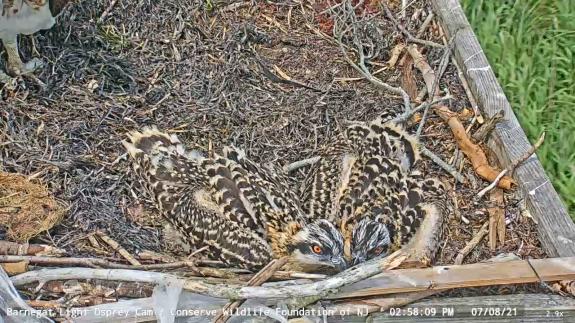 The young ospreys are now fully covered with their body/contour feathers and around 75% of the size of an adult.
The young ospreys are now fully covered with their body/contour feathers and around 75% of the size of an adult.
A lot of fish have been consumed since my last update here. In fact, if you watch on YT the viewers who engage in the chat keep track. It's usually around 7-8 per day. Mostly the male catches menhaden and flounder, but this past week he brought in a smooth dogfish, which was quite a surprise. Ospreys are known to be "specialized generalists" where they will eat just about any fish that they can catch.
The two young have grown quickly, as expected. Now their buff colored body feathers help keep them cryptically colored when laying low in the nest. Now they are starting to stand more and stretch their wings. Two is the perfect number of young for an osprey pair to produce and care for. There is plenty of food to share and the female is able to fatten up a bit as well. It won't be long until she departs for her wintering grounds afterall.
Tomorrow morning their banding is scheduled to begin at ~ 8:15am and be streamed live on YouTube. The weather may have other plans, with a tropical storm moving northeast along the Altantic Coast. We are hopeful that it will move out of the area in time for us to move forward with the planned banding and live stream. At this time we are not sure if we will be able to reschedule to a later date. We will keep everyone updated on the BL Osprey Cam live stream chat if the banding will be canceled or not.
In other news, we have been busy conducting osprey nest surveys, one colony at a time, along the coast of NJ. So far, the colonies we have surveyed are doing quite well, with modest productivity. Follow our NJ Osprey Project FB page for colony by colony results and photos from our surveys.
June 18
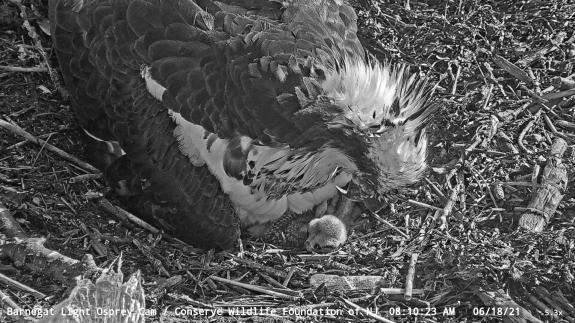 RIP 3.
RIP 3.
A sad situation came to light over the past couple days. 3, the youngest nestling, who was 10 days old, passed away this afternoon. If you've watched the cam then you saw what played out. The older, more aggressive nestlings outcompeted 3 for food, which never allowed it to grow as the others did. As we wrote on our social networks, this is how ospreys are adapted to deal with shortages in prey throughout their range. They exhibit asyncronous hatching and brood reduction - it happened here this season.
Another contributor, in my professional opinion, is the lack of experience of the adult female. At feedings she would eat more than feed to the young. From watching and managing this cam over the past several years, the female provides most food to her young and then she gets the scraps (tail, fins, boney pieces). With that said, she is still doing a great job at her first nesting attempt. It is better to raise two healthy young than three that aren't as fit.
Either way, it is sad to witness but happens throughout their worldwide range. It puts us in our place here on earth as witnesses to the magic of the wild world we live in. It reminds us to not humanize wildlife. They are wild after all. RIP 3.
June 6
Over the past 24 hours, two young have hatched! First hatched yesterday evening at around 5pm and the second this morning around 7:30am. In the morning today the make went to forage and returned with a nice size menhaden, with the head already consumed. He "taloned" it off to the female, where she started to feed herself. Being that this is likely the females first attempt at nesting, she is not very experienced, like the male. She did not start to feed her young first, as any experienced female would do. She was upset with some action on the ground which caused her to flush from the nest with fish in foot. Then she dropped the fish and returned with no meal for her young.
Fast forward another hour and the male leaves to forage again after persistent nagging by the female. The drama continues!
May 19
It's been a while since my last update. As we have all observed, the pair is incubating three eggs! The first was laid on April 27 ~ 4:45pm, second on April 30 ~ 12:30pm ane the third on May 3 ~ 10:30am. Ospreys along the coast typically incubate for 40 days, so we will watch for the first egg to hatch during the week of June 6.
This new female has been doing a great job so far! It is interesting to learn from this as it is her first year (that we know of) producing young. Luckily she has a very experienced mate and is why we say that the success of a nest is centered around the males ability to find and catch prey for his mate and young.
April 23
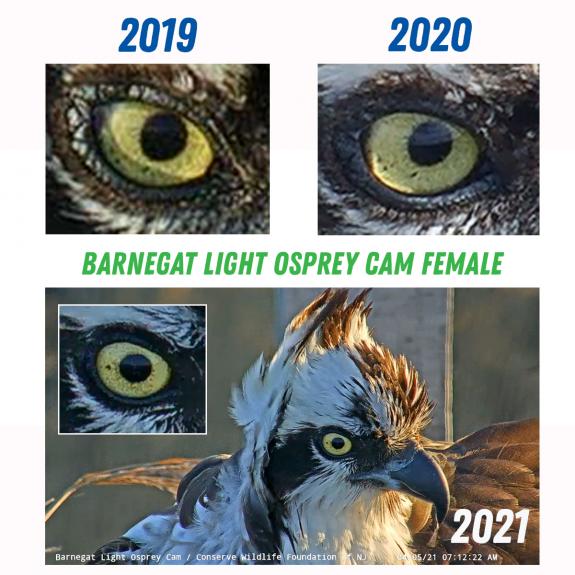 Comparison of the iris of the nesting female from 2019-2021. Yes, she's new but we have seen her in the past!
Comparison of the iris of the nesting female from 2019-2021. Yes, she's new but we have seen her in the past!
Now that we finally have an established nesting pair, we can expect the female to lay an egg in the coming days or weeks. After many battles occurred at the nest, the returning male, a soon to be 15 year old individual (band 788-04933) has formed a pair bond with a new female. She is unbanded, so we don't know her age, but we have seen her in the past. She was observed on the osprey cam nest here last spring, in early April. She was outcompeted by the returning female last year. The fascinating thing is that the young male (1088-08822) who was seen attempting to form a pair bond with her this year was also with her on the nest last spring! So, it seems these two are setting the stage for 08822 to overtake 04933's nest if and when he does not return.
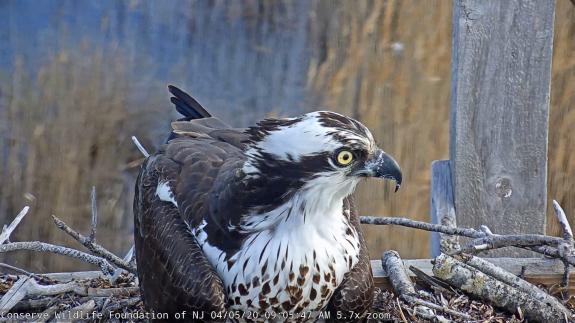 Snapshot of the new 2021 nesting female at the BL Osprey Cam but her on the nest in 2020!
Snapshot of the new 2021 nesting female at the BL Osprey Cam but her on the nest in 2020!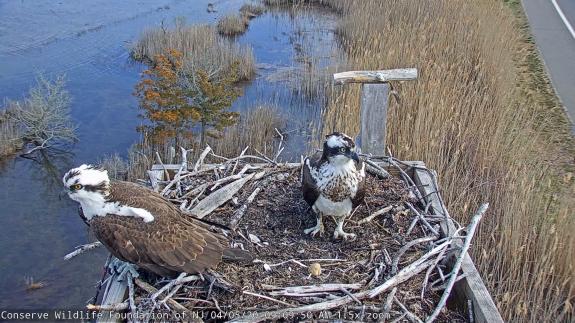 Snapshot of the young male (1088-08822) and unbanded (new 2021 nesting female) on the BL Osprey Cam nest on April 5, 2020.
Snapshot of the young male (1088-08822) and unbanded (new 2021 nesting female) on the BL Osprey Cam nest on April 5, 2020.
This year the previous female did not return and this new female, named Daisy by chatters on YT, outcompeted other females who attempted to overtake this established nest. For the past two years the previous female laid the first egg on April 20. Daisy has yet to lay an egg, which is not surprising since she is new and had to first establish her pair bond with the resident male. Established pairs are known to lay eggs sooner. We have no doubt that this female is of breeding age, with adult plumage and a pale yellow iris.
Many viewers on YT are trying to guess when the first egg will be laid. This is very hard to predict, especially with a new female. What we know is that when she is ready to lay she remains very close to the nest bowl and spends the night on the nest. When she is getting close she often looks tired and shuts an eye to rest, even during the day. My bet is for her to lay the first egg on April 24. :) -Ben
April 14
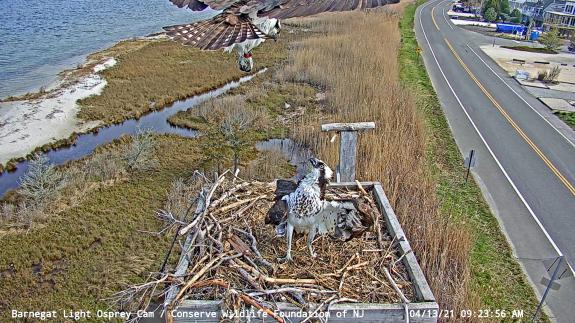 Elite red banded osprey, 18/H comes into view of the BL Osprey Cam at 9:23am on April 13.
Elite red banded osprey, 18/H comes into view of the BL Osprey Cam at 9:23am on April 13.  Zoom+ Enlarged detail of 18/H red band.
Zoom+ Enlarged detail of 18/H red band.
Viewers reported a red banded osprey that came into view of the camera at 9:23am on April 13. After reviewing the footage, frame by frame, I was able to confirm the band #, which is 18/H. 18/H was banded in 2017 at Sedge Island. This might not have been the first time that this bird has been re-sighted in NJ. Last summer when conducting a survey along the shoreline in Bayville we spotted a red banded adult in flight. He was circling with several other ospreys and I got some photos of him, but he was pretty distant and the band was just barely readable. I was not 100% sure that the band was 18/H, so I didn't report to USGS. I was hoping we would see this bird again and now we have! I did just report 18/H to USGS.
In other news, more battles at this nest are underway. Now it appears two females are duking it out. Is the resident female back!?! One hasn't sat on the nest long enough to make a positive ID, so again, time will tell who will reside at the nest this year. With more and more ospreys returning to breed here, there is more competition at established nests. This is becoming more and more common as more birds survive to reach adulthood and the best nest sites are limited.
April 9
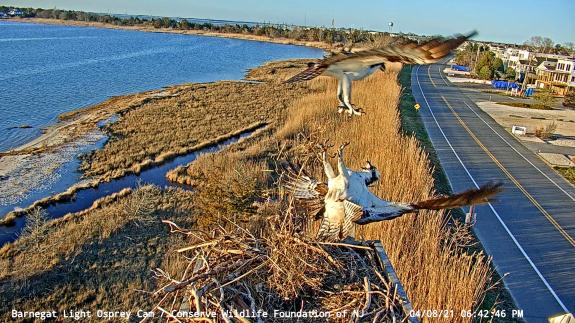 'Tis the season for upside down ospreys!!
'Tis the season for upside down ospreys!!
Viewers have gotten quite the show over the past couple weeks and more so in the past few days. Since my last update the pair observed on the nest are not the nesting pair from last year, but are two birds that were seen on the nest early in the 2020 nesting season. We can tell who is who by their band (male) and iris (female). This pair was seen together on this nest last spring, before the residents returned and re-established their dominance.
Over the past two days there have been two males duking it out. After multiple dive bombs, foot grabs and holds, the younger male has been outcompeted by the resident male, who will be 15 years old this summer. Last night he finally claimed his nest back after arriving on April 7 and battling with the six year old to claim his nest. We got some great images and video of him as he finally got to relax at his home on LBI. The six year old sustained some injuries, as blood was visible on his breast. The 14 year old returning male seems unphased.
So far today he has been guarding the nest and feeding nearby. He now awaits his mate, since he has driven off the new female. It will be interesting to see what happens if she doesn't return.
This weekend I'll put together some graphics showing the eyes of each female to highlight the differences. With the males it is much easier since both are banded. I'll also put together a highlight reel from the past week showing some of the battles that have occurred. -Ben
March 28
 Two birds on the nest at the BL Osprey Cam on 3/27/21 at 8:45am.
Two birds on the nest at the BL Osprey Cam on 3/27/21 at 8:45am. Left iris of 1088-08822, banded in July 2015, who attempted to takeover previous male in 2020. It appeas that he is back and hoping to win over the female again.
Left iris of 1088-08822, banded in July 2015, who attempted to takeover previous male in 2020. It appeas that he is back and hoping to win over the female again.
Yesterday morning, as I drove to a local coastal cleanup with my family in High Bar Harbor, I passed this nest and saw two birds on the nest! The adult female, who looks to be the same as last year, was joined by an adult male. He is the same male who attempted to overtake the nest from the 13 year old male. His band is 1088-08822 and I banded him as a nestling in July 2015. 08822 will need to step up and provide some prey for the female to help win her over. It is interesting to see him back, after he got outcompeted last spring. Where was he all summer? Interesting to see how turnover of the breeding pair occurs at nests. If the 13 yr old male does not return, then it sure seems that 08822 is set to take over. Time will tell. -Ben
March 24
Excited to report that an osprey has been seen on the nest! One graced the sky during sunset on March 22 and then the first seen on the nest was early March 23 (three days later than 2020). It is hard to see if this bird is banded in the video above. He (or another) osprey has been observed on the nest today and a band was noted by watchers on his left leg. If true, could this be the young adult male who tried to usurp the resident male last year? Is it another male? Again, time will tell.
Thank you to everyone who has donated to support the osprey cam! Next week we are planning to visit the nest to make some last minute adjustments if the weather holds out. We had to cancel these plans during the winter, so we're hopeful that things work out. We're planning to replace the perch with a longer one, to accomodate more perching ops for the fledgling young, clean the camera lens, and replace the windscreen on the mic, that may have been lost over the winter.
March 19
We highlight some of Bobby's contributions to the osprey cam last summer in the video above. Last year the first osprey was observed on the nest on March 20. Will we see one on the same day? Time will tell.
March 8
The 2021 nesting season is dedicated in memory of Bobby Jetton or "Twist," as known by chatters on YouTube. He came on board to help control the cam and moderate chat in July 2020 and left a lasting impression. As a former IT tech and security camera expert, he helped improve the settings for the cam and captured amazing views while engaging many hundreds of viewers. He passed away in late February 2021 and is missed very much. For those who were inspired by Twist's interaction and camera operation are encouraged to support the BL Osprey Cam in his memory.
A few ospreys have been observed in New Jersey, so it won't be long until we see some back on LBI. The camera is now recording during daylight hours, so if you see something, please let us know!
March 1
Spring is near and in the coming days and weeks North American ospreys will begin their northward migration to their breeding grounds. Last year an osprey was first seen on the platform on March 23. The adult female arrived around April 8. The resident male after that. This nest has become very popular to other ospreys, since there are few suitable nests in the area (except for another tall platform in the distance, which we placed a nestbox on several years ago). We can expect some action at this nest in the coming weeks. Did the resident pair survive? The male will be 15 years old this summer. After what happened last summer, we really hope he is alive and well and returns. Time will tell.
We will visit the cam in the coming weeks for some light maintenance.
January 2021
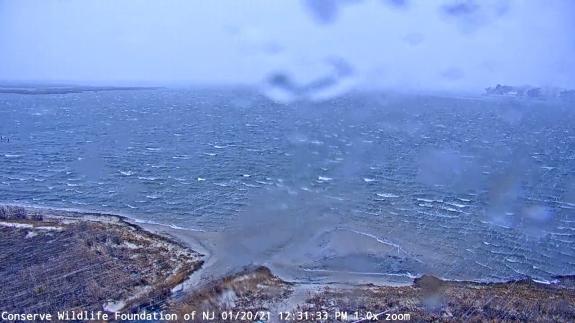 Brief period of heavy snow and wind as a squall line passed through Barnegat Light.
Brief period of heavy snow and wind as a squall line passed through Barnegat Light.
The countdown to the spring arrival of ospreys has begun. We are planning to do some maintenance to this camera at some point before the nesting pair arrives back in early April. If the male returns, he will be 15 yrs old this summer. Maybe we'll throw him a party by banding his young with colorful red aux. bands. :)
If you enjoy this live view, please consider making a donation.
Find Related Info: Osprey




